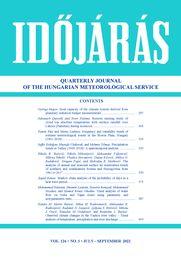Időjárás - Quarterly Journal of the Hungarian Meteorological Service (OMSZ)
Vol. 126, No. 3 * Pages 297–423 * July - September 2022
 |
|
 download [pdf: 2988 KB]
download [pdf: 2988 KB]
Heat capacity of the climate system derived from planetary radiation budget measurements
György Major
DOI:10.28974/idojaras.2022.3.1 (pp. 297–304)
György Major
DOI:10.28974/idojaras.2022.3.1 (pp. 297–304)
Remote sensing study of cloud top absolute temperature with surface rainfall over Lahore (Pakistan) during monsoon
Jahanzeb Qureshi and Noor Fatima
DOI:10.28974/idojaras.2022.3.2 (pp. 305–318)
Jahanzeb Qureshi and Noor Fatima
DOI:10.28974/idojaras.2022.3.2 (pp. 305–318)
Frequency and variability trends of extreme meteorological events in theMoson Plain, Hungary (1961–2018)
Tamás Füzi and Márta Ladányi
DOI:10.28974/idojaras.2022.3.3 (pp. 319–334)
Tamás Füzi and Márta Ladányi
DOI:10.28974/idojaras.2022.3.3 (pp. 319–334)
Precipitation trends in Turkey (1969–2018): A spatiotemporal analysis
Saffet Erdoğan, Mustafa Ulukavak, and Mehmet Yılmaz
DOI:10.28974/idojaras.2022.3.4 (pp. 335–353)
Saffet Erdoğan, Mustafa Ulukavak, and Mehmet Yılmaz
DOI:10.28974/idojaras.2022.3.4 (pp. 335–353)
The analysis of annual and seasonal surface air temperature trends of southern and southeastern Bosnia and Herzegovina from 1961 to 2017
Nikola R. Bačević, Nikola Milentijević, Aleksandar Valjarević, Milena Nikolić, Vladica Stevanović, Dušan Kićović, Milica G. Radaković, Dragan Papić, and Slobodan B. Marković
DOI:10.28974/idojaras.2022.3.5 (pp. 355–374)
Nikola R. Bačević, Nikola Milentijević, Aleksandar Valjarević, Milena Nikolić, Vladica Stevanović, Dušan Kićović, Milica G. Radaković, Dragan Papić, and Slobodan B. Marković
DOI:10.28974/idojaras.2022.3.5 (pp. 355–374)
Markov chain analysis of the probability of days in a heat wave period
Árpád Fekete
DOI:10.28974/idojaras.2022.3.6 (pp. 375–385)
Árpád Fekete
DOI:10.28974/idojaras.2022.3.6 (pp. 375–385)
Trend analysis of water flow on Neka and Tajan rivers using parametric and non-parametric tests
Mohammad Salarian, Shamim Larijani, Hossein Banejad, Mohammad Heydari, and Hamed Benisi Ghadim
DOI:10.28974/idojaras.2022.3.7 (pp. 387–402)
Mohammad Salarian, Shamim Larijani, Hossein Banejad, Mohammad Heydari, and Hamed Benisi Ghadim
DOI:10.28974/idojaras.2022.3.7 (pp. 387–402)
Observed climate changes in the Toplica river valley - Trend analysis of temperature, precipitation and river discharge
Nataša M. Martić Bursać, Milan M. Radovanović, Aleksandar R. Radivojević, Radomir D. Ivanović, Ljiljana S. Stričević, Milena J. Gocić, Ninoslav M. Golubović, and Branislav L. Bursać
DOI:10.28974/idojaras.2022.3.8 (pp. 403–423)
Nataša M. Martić Bursać, Milan M. Radovanović, Aleksandar R. Radivojević, Radomir D. Ivanović, Ljiljana S. Stričević, Milena J. Gocić, Ninoslav M. Golubović, and Branislav L. Bursać
DOI:10.28974/idojaras.2022.3.8 (pp. 403–423)
IDŐJÁRÁS - Quarterly Journal

Az IDŐJÁRÁS a HungaroMet Nonprofit Zrt. negyedévenként megjelenő angol nyelvű folyóirata
Megrendelhető a journal.idojaras@met.hu címen.
A szerzőknek szánt útmutató itt olvasható.
Megrendelhető a journal.idojaras@met.hu címen.
A szerzőknek szánt útmutató itt olvasható.









